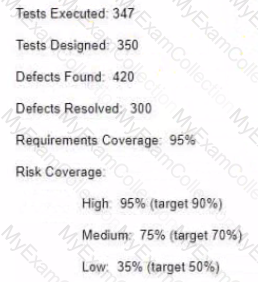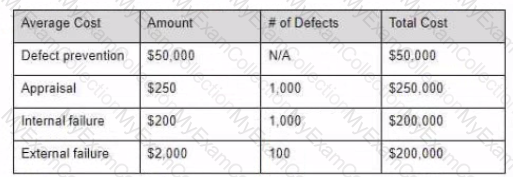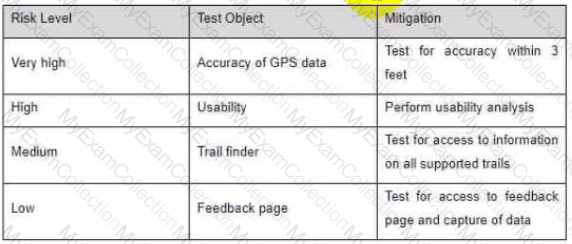You feel that your team has become lazy when applying good software testing techniques You have given each of them a challenge to take a different business rule and build a full decision table and then collapse that table You will then assess the results For this assessment, whatcompetencies are you validating?
Which ofthe following Is the common setof information to be produced in a test estimate''
In an Agile project, when Is it acceptable lo not write a formal defect report when a defect is found''
You have been asked to make a recommendation on deployment readiness on the software your team has been testing.You have the following metrics:

Given this information what is a critical metric you are missing?
You have decided to help your team improve their skills. One of their assignments is to mentor a junior member of the team Which competency should you expect the mentor to develop during this exercise?
There is a debate in your organization about who can close a defect report The developers think theyshould be able to reject and close defects without any further steps The testers are not happy with this approach as they are afraid the rejections may go undetected and the developers may close something without understanding the real problem
How can this problem be rectified7
You have assembled the following cost of quality numbers 1 000 defects were found prior to release and 100 were found after.

Given this information what should you conclude?
Your team has been working on anAgile project for two months.There is a retrospective at the end of each sprint One of the data items reviewed is how many defects are being caught by users rather than bytesters.The test team is being blamed for these escapes
What do you need to do to make these sessions more productive?
Your team has been assigned to a new project You have a mix of manual testers and automation engineers but everyone is currently doing manual testing.The development learn has already decided to use DevOps as its approach but they have never used it before and are happy to take your input Unfortunately, about 50% of the development is completed already In the testing your team is doing they are finding that about 40% of the defects they catch are actually regressions caused by other changes
Given this information what should you do to help mitigate risk'?
You are working on a project that is having problems with regressions. Witheach release of software given to the test team. 50% of the defects found are actually regressions.To combat this you have decided to implement test automation.You have given your automation team the following goal
'Implement lest automation to automate 90% of the manual regression tests before the productrelease date.’’
Which of the following is likely an issue with this goal being defined as "SMART?
You are managing the test team that is testing a new mobile application that provides a "step-by-step' hiking guide Your risk assessment resulted in the following table:

Your team has clone the depth and breadth testing for the GPS accuracy and usability features but when the product was given to beta testers there were some issues Despite the users reporting the app was easy to use at least one user walked off the edge of a cliffand another one ended up in a river.Your team has confirmed that the functionality is working correctly. and the GPS information is accurate.
What other area of testing should you now prioritize?

